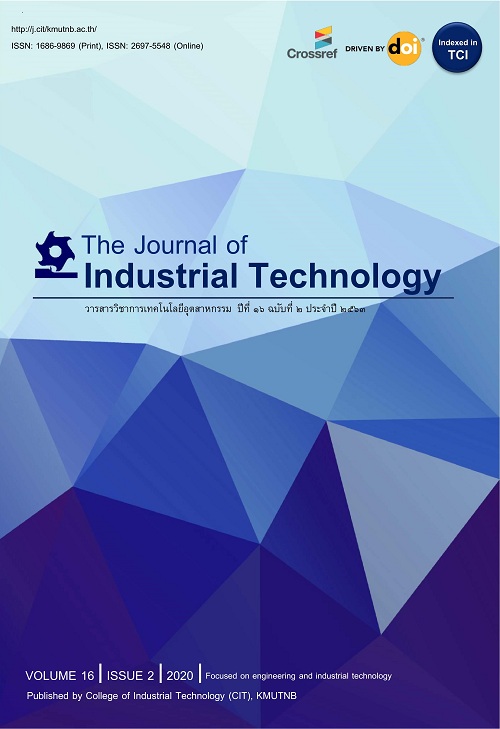Effect of the Ternary Blends (Ethanol-Biodiesel-Diesel) on Deterioration of a Stationary Agricultural Engine
Abstract
This study determines the effect of ethanol in the ternary blend on the long-term use of the engine. A stationary agricultural engine is selected for the 500-hour endurance test because of the high feasibility of using ethanol blends as regular in the future. Ethanol 10 % (E10) is mixed with the blend of biodiesel 10% and 90% diesel (B10). So, the test fuel is B10E10. Commercial diesel, which has 7% biodiesel, is also used for the comparison. To simulate the actual application, the engine connected to a water pump was operated to circulate the water. The engine deterioration is evaluated through the change in performance and emissions when compared after 500 hours of use and before the beginning of the test. The engine wear is denoted by the metal contamination in lube oil. Also, the appearance and measured value of parts from the disassembled test engine are used to reveal the engine damage. Moreover, engine oil degradation was also checked by the oil condition and the additive depletion. The results found that torque and fuel consumption changed and indicated engine deterioration as usual. According to lubricant oil results, there is no effect of ternary blend superior to the commercial diesel. No evidence of severe wear can be detected. The engine can run smoothly throughout the test without any adverse consequences. Therefore, the use of ethanol-blended fuel in agriculture engines can expand.
Keywords
[1] I. P. de Oliveira, A.R.L. Caires, K. Baskar, S. Ponnusamy, P. Lakshmanan and V. Veerappan, Biodiesel as an additive for diesel-ethanol (diesohol) blend: physical-chemical parameters and origin of the fuels’ miscibility, Fuel, 2020, 263, 116753.
[2] I.P. de Oliveira, C.H. Lescano, W.J.N. Lima, U.A. Pereira, C.M. Aguilar, V. Velusamy, P. Sasikumar, M. Vimalan, K.G. Kumar and K. SenthilKannan, Physical-chemical properties of biodiesel–diesohol blends: Ultrasonic and molecular simulation studies, Journal of Molecular Liquids, 2023, 388, 122755.
[3] V. Kulanthaivel, A. Jayaraman, T. Rajamanickam and S. Selvam, Impact of diesel-Algae biodiesel-anhydrous ethanol blends on the performance of CI engines, Journal of Cleaner Production, 2021, 295, 126422.
[4] T. Sathish, V. Mohanavel, M. Arunkumar, K. Rajan, M.E.M. Soudagar, M.A. Mujtaba, S.H. Salmen, S.A. Obaid, H. Fayaz and S. Sivakumar, Utilization of Azadirachta indica biodiesel, ethanol and diesel blends for diesel engine applications with engine emission profile, Fuel, 2022, 319, 123798.
[5] L. Zuo, J. Wang, D. Mei, S. Dai and D. Adu-Mensah, Experimental investigation on combustion and (regulated and unregulated) emissions performance of a common-rail diesel engine using partially hydrogenated biodiesel-ethanol-diesel ternary blend, Renewable Energy, 2022, 185, 1272-1283.
[6] R. Subramanian, G. Rajendiran, R. Venkatachalam, N. Nedunchezhian and K. Mayilsamy, Hybrid fuel blends-the alternative fuel for transport bus engine, SAE Technical Paper, 2009, 2009-28-0032.
[7] A. Murcak, C. Haşimoğlu, İ. Çevik and M. Karabektaş, G. Ergen, Effects of ethanol–diesel blends to performance of a DI diesel engine for different injection timings, Fuel, 2013, 109, 582-587.
[8] A. Mohammadi, T. Ishiyama, T. Kakuta and S. Kee, Fuel Injection strategy for clean diesel engine using ethanol blended diesel fuel, SAE Technical Paper, 2005, 2005-01-1725.
[9] Z. Wang, S. Wu, Y. Huang, S. Huang, S. Shi, X. Cheng and R. Huang, Experimental investigation on spray, evaporation and combustion characteristics of ethanol-diesel, water-emulsified diesel and neat diesel fuels, Fuel, 2018, 231, 438-448.
[10] S. Dharma, H. Chyuan Ong, H.H. Masjuki, A.H. Sebayang and A.S. Silitonga, An overview of engine durability and compatibility using biodiesel–bioethanol–diesel blends in compression-ignition engines, Energy Conversion and Management, 2016, 128, 66-81.
[11] I. Temizer and A. Arı, Effects on ring wear of bioethanol/diesel fuel blends used at long term endurance tests in a DI engine, International Journal of Automotive Engineering and Technologies, 2022, 11, 140-151.
[12] S.K. Kurre, S. Pandey, N. Khatri, S.S. Bhurat, S.K. Kumawat, S. Saxena and S. Kumara, Study of lubricating oil degradation of ci engine fueled with diesel-ethanol blend, Tribology in Industry, 2021, 2, 222-231.
[13] J. Thawornprasert, A. Sopajarn, S. Niseng, P. Suybangdum, W. Duangsuwan and K. Somnuk, Effect of diesel-palm fatty acid distillate ethyl ester-hydrous ethanol blend on the performance, emissions, and long-term endurance test on an unmodified di diesel engine, ACS Omega, 2022, 7, 5894-5907.
[14] S.K. Kandasamy, A.S. Selvaraj and T.K.R. Rajagopal, Experimental investigations of ethanol blended biodiesel fuel on automotive diesel engine performance, emission and durability characteristics, Renewable Energy, 2019, 141, 411-419.
[15] M.V. Twigg, N.R. Collins, D. Morris, T.J. O'Connell, I.K. Ball, S. Arrowsmith, L. Cassidy and P. Wrench, The effect of phosphorus and boron lubricant oil additives on catalyst and engine durability, Journal of Fuels and Lubricants, 2004, 113, 948-959.
DOI: 10.14416/j.ind.tech.2024.08.015
Refbacks
- There are currently no refbacks.






